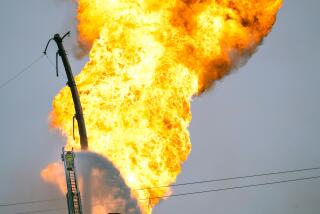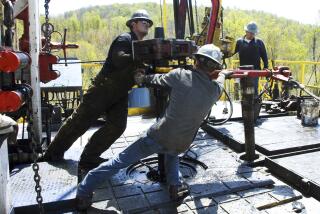Proposed Keystone XL oil project draws a divisive line
Reporting from Atkinson, Neb.
Some might have been surprised to hear that plans to build a 1,700-mile oil pipeline through the Midwest to the Gulf Coast — a source of new oil and thousands of jobs — would drive an emotional fault line down the middle of the conservative heartland. But any skepticism would have quickly evaporated here in the noisy bleachers of the West Holt High School gymnasium.
The proposed Keystone XL pipeline — the subject of public hearings convened by the State Department last week along the route from Montana to Texas — was alternately described as a plot by a foreign corporation to exploit America, a potentially perilous polluter of the nation’s greatest freshwater resource, the answer to America’s energy insecurity, a generator of the last great family-wage jobs and, oh yes, a dangerous new instigator of global warming.
Possibly it is all of these things. That’s why the determination of whether it’s in the “national interest” to build the $7-billion Keystone XL pipeline is shaping up as one of the most fraught political and environmental battles the Obama administration faces as it goes into the 2012 election. The State Department says it will make its determination by the end of the year.
Over this pipeline, both major parties’ traditional political bases are at each others’ throats — environmentalists versus organized labor, oil industry versus farmers and ranchers — in a way that has turned typical politics on its head and caused Nebraska to emerge as, unexpectedly enough, a pivot point on national policy.
For environmentalists, the Canadian pipeline company TransCanada’s Keystone XL project has become a symbol of rampant greenhouse gas emissions; for business, a generator of jobs and competition with China; for impoverished neighborhoods that will be the recipients of the oil’s emissions, an example of social injustice; for the new oil boomtowns in Montana, North Dakota and South Dakota, a way to get their product to market.
“When I came into town, the highway was lined with American flags. But you know what? I did not see one Canadian flag. So why is a foreign corporation in our country, in our state, dictating to us where they’re going to put a giant pipeline?” Randy Thompson, a landowner in Merrick County, Neb., who’s been fighting TransCanada, said at last week’s hearing in Atkinson. “Maybe it’s time for America to stop being a doormat and we get some politicians that actually have some backbone.”
Thousands of miles of oil and gas pipelines already snake across the Midwest, including the initial Keystone pipeline, which opened in 2010, that carries Canadian crude oil into the U.S. as far as Oklahoma and Illinois.
Residents emphasized that they were not opposed to pipelines — just to burying one under the Sandhills. The Sandhills are the biggest undisturbed natural ecosystem in the Great Plains, full of cranes and herons and tundra swans, yet highly vulnerable to erosion when dug up or otherwise disturbed.
The proposed 36-inch-wide steel pipeline would carry the highly viscous bitumen extracted from Alberta’s tar sands under processes that create substantial greenhouse gas emissions, one of the issues the State Department will consider in deciding whether the pipeline is in the national interest.
On the plus side, the pipeline would shift some of America’s energy focus from the Middle East toward its ally and biggest trading partner. TransCanada says it would lead to more than 120,000 new U.S. jobs, 7,500 of them in Nebraska, and $20 billion in economic growth, including more than $11 million in state and local taxes for Nebraska.
Ordinarily, this is a program that a state like Nebraska, which last voted for a Democratic presidential candidate in 1964, could easily get its arms around. But the pipeline’s proposed route across the fragile Sandhills and the Ogallala aquifer — an underground basin the size of Lake Erie that provides water to much of Nebraska and seven other states — has caused normally conservative farmers and ranchers to take up protest banners and write hate mail to their Republican legislators.
Last week, with the State Department road show coming to town, the Lincoln Journal Star declared it was “time to stand up for the Sandhills.”
“In Memorial Stadium, fans know that when the opposing team is approaching the end zone, it’s time to stand up and get loud. Supporters of the perilous pipeline route now are reaching for the end. Get loud,” it advised.
So people did.
A network of water
The grass-covered Sandhills stretch across 20,000 square miles of northern Nebraska, with their sand acting as a natural filter for the Ogallala aquifer underneath.
The land in this part of Nebraska is as productive as it is because the aquifer’s water table is so high, with the water often running right up to the root lines; in many areas, the water forms puddles and ponds on the surface, and sprouts free-flowing artesian wells.
“If they have a leak, well, 40% of what’s running through that pipeline is carcinogens. So they say they’d only ruin a little bit of the aquifer. Well, a little bit’s too much. This is our lifeblood here, this water,” said rancher Todd Cone, plunging a posthole digger into the prairie grass and drawing water just 10 inches below.
Cone and fellow ranchers frequently mention last year’s leak on a much older tar sands oil pipeline in Michigan that spilled 840,000 gallons of oil into a creek linked to the Kalamazoo River, resulting in $700 million worth of damage. The original Keystone pipeline system has had 14 leaks in its 12 months of operation, substantially more than expected, though all of them were small and located at pump stations, not in the pipeline itself.
TransCanada officials have pledged significant safety measures, including installing backup electrical power, burying the pipeline deeper, and increasing the number of shut-down valves. Heidi Tillquist, the company’s outside consultant on hydrology issues, said any spills would be contained within a small area and would be unlikely to contaminate wells.
“One misconception a lot of people have is, it’s an underground reservoir, so if you contaminate one area, it spreads indefinitely. But it’s a sedimentary formation — sands, gravels and silts. Groundwater moves through that only one foot a day, 365 feet a year,” Tillquist said in an interview.
“If I was a landowner here, yeah, I’d have some concerns. But once you start explaining it, that you’re talking [oil that would spread only] tens to hundreds of feet … you can see the light bulb go off and they say, ‘Oh yeah. That makes sense. My well is 100 feet down, and I’m not going to have problems.’ ”
Ranchers said Tillquist might think differently if she had ranched this land the way they had over a lifetime. It is common knowledge, they say, that when farmers 15 miles away on the lowlands start ramping up the irrigation pumps in the summer, the free-flowing wells up on the edge of the Sandhills start slowing right away. Then in the fall, when the pumps shut down, the wells get speedily recharged with groundwater from many miles upland the other way.
“Well, that’s 30 miles of water right there, and it’s moving pretty fast,” fourth-generation rancher Bruce Boettcher said.
A selling point
TransCanada has picked the perfect promotional message for a nation transfixed with the economy and turmoil in the Middle East.
“The question is, do we want to buy oil from Canada, North Dakota and Montana, or do we want to increase our dependence on OPEC?” Robert Jones, vice president for the Keystone project, said in an interview before Thursday’s hearing in Atkinson. “Right now, there are millions of Americans out of work. We are in every definition a shovel-ready project, and we can put 20,000 Americans to work tomorrow.”
Dozens took up the theme at the hearing, many of them bused in from union halls across the Midwest.
“If we don’t secure and refine this oil, then China will,” said union member David Barnett.
The hometown crowd was sympathetic — their children will probably go down and apply for jobs too, if it comes to it — but couldn’t they build it, people kept wondering, somewhere else? Somewhere not so magical as the Sandhills?
What will they tell their children? asked Maggie Conrad, a Navy veteran and stay-at-home mother from Burwell. “Can you look your child in the eye and say, ‘Sorry, Gracie, I sold your future, your livelihood, to some overrated, two-bit oil company?’ ”
More to Read
Sign up for Essential California
The most important California stories and recommendations in your inbox every morning.
You may occasionally receive promotional content from the Los Angeles Times.










